DK Human Body: Nervous System
The brain, nerves, and spinal cord make up the nervous system. It processes information from the sense organs and controls conscious “voluntary” actions, such as walking, and “involuntary” processes we are not aware of, like reflexes and breathing.
Nerves are the cables of the nervous system. Each nerve is packed with hundreds of wirelike cells called neurons, which carry electric signals to and from the brain. The brain and spinal cord form the central nervous system, and the nerves outside them are the peripheral nervous system.
Neurons work like wires, transmitting electric signals. When the neuron is resting, an electric charge builds up inside it. If triggered, a nerve impulse rushes to the end of the cell, where a chemical called a neurotransmitter passes the signal to the next neuron across a gap, or synapse.
There are three main types of neurons. Sensory neurons carry incoming signals from sense organs to the central nervous system. Motor neurons carry outgoing signals from the brain to the body, usually to muscle cells. Association neurons form a complex maze of connections in the brain and spinal cord, linking sensory neurons to motor neurons.
All neurons are similar in structure to a motor neuron. The cell body contains the nucleus that controls the cell. Filaments called dendrites branch out from the cell body and pick up signals from other neurons. The nerve fiber, or axon, takes the signal and passes it on to other neurons, muscles, or glands.
Reflex actions are involuntary—they happen before you have time to think. When they happen, a nerve signal takes a shortcut through the spinal cord, rather than involving the brain. If we touch a very hot object, a sensory neuron sends a signal shooting from the hand to the spinal cord. There an association neuron transmits the signal to a motor neuron, which tells a muscle in the arm to move the hand.

